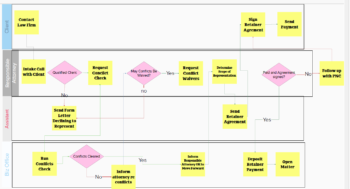Enhance Internal Communication at Law Firms for Greater Profitability and Growth

Lawyers have a way with words. But that doesn’t mean they’re great at communicating, especially within their firm. In our work with law firms, we’ve come across some common signs that a law firm is struggling with internal communication:
- Lawyers aren’t clear about what their colleagues do
- Partners are reluctant to “share” clients
- Attorneys rarely collaborate across practice groups
- Disjointed and mixed messaging in marketing efforts

These communication gaps result in missed opportunities for additional work, client dissatisfaction, reduced knowledge sharing, and limited problem solving. In this guide, we will show you 5 strategies to address these issues and the positive impact they’ll have on your firm’s profitability.
Why Law Firms Need to Get Better at Internal Communication
Most lawyers are good at external communication like oral argument, presentations within their industry and advising clients on strategy. A practice doesn’t grow and thrive if you can’t do these things. The role of internal communication is equally important to the health of the firm for several reasons:
- Client Satisfaction and Retention Open communication internally ensures that clients received consistent and accurate information. When clients have a seamless experience across the firm, they are more likely to stay.
- Streamlined Operations Save attorneys and staff time with better communication and reduce errors, delays, and redundant work.
- Cross-Practice Collaboration Cross-practice collaboration has a significant positive impact on revenue growth and it depends on open communication.
- Employee Engagement Attorneys and staff who feel informed and connected are more engaged, more productive, and less likely to leave.
- Risk Mitigation Clear communication within a law firm reduces misunderstandings and minimizes risks.
Strategies for Improving Internal Communication
Let’s dive in to several tools and techniques that can help your law firm be more efficient and more profitable.
Workflow Mapping
A workflow map is a visual representation of a process for accomplishing a particular task. When you include the entire team in building it, the map can bring communication issues to light. The map makes it easy for everyone to see what they need to do, when they need to do it, and where their work goes next. A workflow map looks something like this, where each “lane” across represents a person or role:

Project Management Tools
A workflow map continues to provide value only if it is implemented. Build a system that automatically alerts people when it’s time for their task to be done. Project management software can help. We’re big fans of ClickUp, but there are many others out there like Monday, Trello, and Asana.
Project management tools also allow teams to communicate within the platform, by tagging, mentioning, or commenting on tasks or using chat features. This helps keep related conversations together. Questions about specific assignments are kept inside the assignment’s entry.
Messaging Platforms
In addition to project management tools, there are other tools specifically for internal communication. If your firm has Microsoft 365, encourage attorneys to use Microsoft Teams for internal communication. Teams is a great way to keep matter-specific conversations together, instead of having to dig through your inbox. Slack is a good alternative if you don’t want to use Teams.
Tip: Incentivize use by offering gifts for people who send the most messages in a week or month.
Designate a Primary Method for Firm Communications

There are many different tools available for communication. There are traditional methods such as picking up a phone and email. (Ok, email may not be “traditional” for those of us in Gen X and over.) And there are a whole slew of other tools, like texting, instant messaging (aka “DMs”), Teams, Slack, and other chat platforms. While variety might be the spice of life, choosing a primary mode of communication, over allowing unrestricted communication channels within a law firm has several advantages:
- Centralization and Consistency:
o Why: A primary platform ensures that all communication occurs in one place.
o Importance: Consistency simplifies information retrieval, reduces confusion, and streamlines workflows. - Efficient Collaboration:
o Why: Using one platform for real-time chat enables file sharing, and collaboration.
o Importance: Attorneys can quickly exchange information, discuss cases, and work together seamlessly. - Document Management:
o Why: Communicating on one channel is a form of version control.
o Importance: Centralized document storage ensures everyone accesses the latest versions, reducing errors. - Security and Compliance:
o Why: Primary platforms can enforce security protocols and compliance standards.
o Importance: Protecting sensitive client data and maintaining legal compliance is critical. - Reduced Email Overload:
o Why: Limiting email usage prevents overflowing inboxes.
o Importance: Attorneys can focus on substantive legal work instead of managing emails. - Cultural Shift and Adoption:
o Why: A designated platform encourages a collaborative mindset.
o Importance: Attorneys adapt to a shared communication culture, reinforcing collaboration.
Firms can expect that at least a few partners, associates, and staff will balk at being told they have to use the primary mode. Check out our post on Building Buy-In for tips on how to address this challenge.
Try Cross-Practice Huddles
Cross-practice huddles are short, regular meetings where partners from several practice groups share insights. The agenda should be short and identical every time. Lawyers report what has gone well since the last meeting, what they’re working on now, and 1 or 2 questions they’d like to ask the group. Firms that have implemented this strategy have discovered new potential client work and saw regular revenue growth.
Yes, huddles are a type of meeting, and yes, they will take some time that could be spent on billable work. But we think they’re worth it because of their many benefits:
- Holistic Problem-Solving:
o Cross-practice huddles bring together diverse legal minds. Attorneys from different areas share insights, perspectives, and creative solutions.
o Collaborative problem-solving often leads to more comprehensive and innovative approaches. - Breaking Silos:
o Legal work can become siloed, with attorneys narrowly focused on their practice areas.
o Huddles break down these barriers, fostering a sense of unity and shared purpose.
o Attorneys learn about other practice areas, enhancing their overall legal knowledge. - Quick Wins and Efficiency:
o While huddles take time, they often lead to quick wins.
o Immediate solutions emerge, saving time in the long run.
o Efficiency increases as attorneys learn from each other’s experiences. - Relationship Building:
o Huddles strengthen professional relationships.
o Attorneys get to know colleagues beyond formal interactions.
o Trust and camaraderie grow, enhancing teamwork. - Spotting Opportunities:
o Attorneys discover cross-practice opportunities during huddles.
o Referrals between practice areas increase, benefiting both clients and the firm.
Talk Amongst Yourselves
By embracing open dialogue, leveraging collaborative tools, and fostering an environment of open communication, law firms can not only enhance their operational efficiency but also drive meaningful growth.
If you’re looking for ways to improve internal communication at your law firm, consider our Strategic Growth Intensive which will help you design solutions tailored to your firm.
